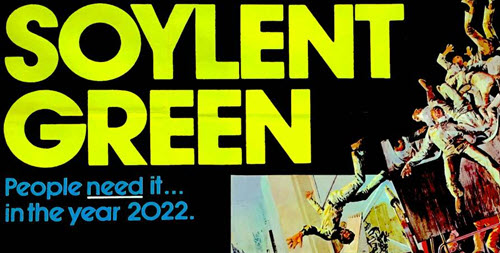Welcome to 2022, where climate change is heating the planet, corporations control the government, and only 1 percent of the population can afford the luxuries of the day.
This rant is not a social media post from someone trolling for a reaction. It describes the world of Soylent Green, a 1973 movie set in the year 2022, where things are really bleak.

It can be fun to look at flicks set in the future that’s now our present. Back to the Future 2 shows 2015 with smart homes similar to how we use smart speakers such as Alexa or Google Play. But where are the flying cars? Other times films in this genre can be disturbing. Soylent Green shows a dystopian 2022 as a place of catastrophic climate change with a starving overpopulated world. The few who are wealthy live like kings and queens while the masses depend on a food supplement called Soylent Green to survive.
Soylent Green was one of the first movies to use the phrase “greenhouse effect.”
The name Soylent Green doesn’t exactly grab you as appealing. It sounds like a medical condition to be avoided. But the future fictitious sustenance derived its name from the source material, a 1966 science fiction book by Harry Harrison called Make Room! Make Room! In the novel, the word “soylent” suggests soybeans and lentils. In the movie, the Soylent corporation claims the product is from highly nutritious ocean plankton, thus giving it a green tint.
I don’t want to spoil it for you (not yet anyway), but Soylent Green is NOT from the sea!
Here’s the actual tagline from a movie poster.
It’s the year 2022…
People are still the same.
They’ll do anything to get what they need.
And they need SOYLENT GREEN.
It’s the “People are still the same. They’ll do anything to get what they need” that does grab you, or at least it grabs me.

In the world of Soylent Green, the rich few rule with little concern or empathy for the rest of the planet. Their elite homes are spacious, with amenities most never enjoy, such as clean water and fresh food. Protected by security systems and bodyguards, these high-tech apartments come with concubine servants, referred to as furniture.
On the streets below these luxury towers, masses of people are scooped up by bulldozers as they riot for scraps of Soylent Green.
While somewhat extreme (at least for now), you can see the parallels to our 2022. For the past 40 years, the rich have gotten richer and the poor poorer. According to the Federal Reserve, the wealthiest fifth of Americans holds 88% of the country’s wealth. Meanwhile, a record number of people in the US require food stamps to survive. Even a global pandemic cannot stifle the wealth gap. With some mind-boggling numbers, Forbes showed how the COVID-19 pandemic only increased the affluence of the one-percenters.
Substitute food stamps for Soylent Green, and things look more like the eco-thriller from 1973.
Spoiler alert. Skip the next paragraph if you haven’t seen the movie and don’t want to know the iconic ending.
At the movie’s end, the protagonist NYPD detective Frank Thorn played by Charlton Heston screams what is assumed to be his last words, “Soylent Green is people!” He discovered that the food most people consume to survive is made of humans and not plankton. The scene where he sees covered dead bodies conveyed into a machine and Soylent Green crackers coming out the other side is bone-chilling. It’s a world of cannibalism.
This 1973 film aligns with novels like George Orwell’s 1984, mainstream movies like The Hunger Games, and recently released Don’t Look Up streaming on Netflix. The tone ranges from dark and joyless like Soylent Green and The Handmaid’s Tale to the dark humor featured in Brave New World and Don’t Look Up. But the common ground is they act as signposts to warn of possible danger ahead unless we make a change.
The satirical film Don’t Look Up is a different take on the doomsday genre. The United States government and the population, in general, fail to take the threat of a planet-killing comet seriously. It’s treated as fake news because it doesn’t line up with people’s political views. So people don’t look up from their smartphone addiction and treat this as an inconvenient truth that will go away if ignored.
But Soylent Green and Don’t Look Up share some common themes — they paint a picture of a world controlled by greedy corporations and a population that’s become cynical and decoupled from the real world.
How do we avoid these dystopian prophecies?
The gravity of the 2022 issues in our world can almost overwhelm us. What can I do to make a difference in global climate change? How can I develop a marketing strategy to motivate people with purpose and not just profit?
We could start by looking up.
Start by looking up from our digital devices and looking at the world around us.
We could look up and listen to each other.
Then perhaps we would look up and start to see the warning signs in our 2022 to avoid 2022 portrayed in Soylent Green.
SyFy Wire Article: IT’S PEOPLE! (But it’s also a bad idea.)
https://www.syfy.com/syfy-wire/soylent-green-made-people-science-bad-idea